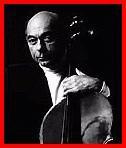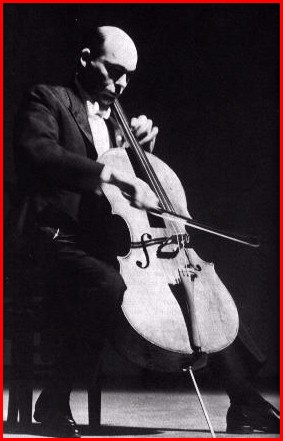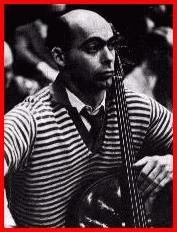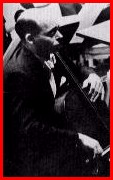Janos Starker
An Appreciation and Interview by
Samuel and Sada Applebaum, 1973 |  |
Born in Budapest, Hungary, July 5, 1924; son of Alexander
and Margarete Starker; educated at Franz Liszt Academy
of Music, Budapest; solo cellist in turn at Budapest
Opera House and Philharmonic, The Dallas Symphony,
Metropolitan Opera, Chicago Symphony; Resident
Professor of Cello at University of Indiana since 1958;
concert artist, lecturer, teacher,
recording artist (Grand Prix du Discque, 1948).
 |  Our first meeting was something of a surprise. The scene was a large home in the hilly suburbs west of New York City. "An evening of chamber music..." so read the invitation to the home of Daniel Vandersall, principal cellist, at that time, of the New Jersey Symphony. Dinner was extremely pleasant, with a guest new to the group--a tall, slim gentleman with piercing eyes, introduced to all of us as Mr. Vandersall's coach at a school near Princeton University. It was a little later, when several of us sat down to play a Brahms sextet, the Opus 36, that we began to realize who our evening's stranger might be. It began with the first note, actually, when an amazingly large, colorful and expressive tone boomed out of his instrument. Our first meeting was something of a surprise. The scene was a large home in the hilly suburbs west of New York City. "An evening of chamber music..." so read the invitation to the home of Daniel Vandersall, principal cellist, at that time, of the New Jersey Symphony. Dinner was extremely pleasant, with a guest new to the group--a tall, slim gentleman with piercing eyes, introduced to all of us as Mr. Vandersall's coach at a school near Princeton University. It was a little later, when several of us sat down to play a Brahms sextet, the Opus 36, that we began to realize who our evening's stranger might be. It began with the first note, actually, when an amazingly large, colorful and expressive tone boomed out of his instrument.
 We asked Mr. Vandersall for more information. The Brahms had gone uncommonly well, and he told us that the cellist was Janos Starker, one of the greatest cellists in Europe and a new arrival in the United States (the year when all this happened was 1950). We reflected later that this had been a most dramatic and effective way to meet a great artist. And we resolved to look him up for more information about himself. This took place more than a decade later, in a rather anonymous type of New York hotel suite. But any place that Starker might be, the air begins to crackle with intensity. We asked Mr. Vandersall for more information. The Brahms had gone uncommonly well, and he told us that the cellist was Janos Starker, one of the greatest cellists in Europe and a new arrival in the United States (the year when all this happened was 1950). We reflected later that this had been a most dramatic and effective way to meet a great artist. And we resolved to look him up for more information about himself. This took place more than a decade later, in a rather anonymous type of New York hotel suite. But any place that Starker might be, the air begins to crackle with intensity.
|
 We found that in the meantime he had become a world renowned artist, a much recorded soloist in every field of cello composition, a teacher with a great reputation for attracting young people to the cello and helping them to master the instrument. How had all this begun, we asked him?
We found that in the meantime he had become a world renowned artist, a much recorded soloist in every field of cello composition, a teacher with a great reputation for attracting young people to the cello and helping them to master the instrument. How had all this begun, we asked him?
 Apparently his parents had handed him a small cello at the age of six and told him this was his instrument. His two older brothers were already playing violins and maybe that was enough for this small household in Budapest. Janos' progress on the instrument amazed everyone, including himself, and, by the time he was eight, he was teaching other children. At nine he became certain that he wanted to do nothing more than to play the cello as well as anyone possibly could. He even became an infant prodigy for a while, but his parents did not push this career too hard. His musical education at the Franz Liszt Academy was the stepping stone that led to a truly remarkable career in modern concert history.
Apparently his parents had handed him a small cello at the age of six and told him this was his instrument. His two older brothers were already playing violins and maybe that was enough for this small household in Budapest. Janos' progress on the instrument amazed everyone, including himself, and, by the time he was eight, he was teaching other children. At nine he became certain that he wanted to do nothing more than to play the cello as well as anyone possibly could. He even became an infant prodigy for a while, but his parents did not push this career too hard. His musical education at the Franz Liszt Academy was the stepping stone that led to a truly remarkable career in modern concert history.
 An important question to us--and apparently to him as well--involved reasons why comparatively few youngsters in the United States take up the cello. Some have the instrument thrust upon them by school teachers eager to get some kind of string program going, an enterprise that calls for cellos. Is it possible that the literature for cello in the elementary grades is not all it should be?
An important question to us--and apparently to him as well--involved reasons why comparatively few youngsters in the United States take up the cello. Some have the instrument thrust upon them by school teachers eager to get some kind of string program going, an enterprise that calls for cellos. Is it possible that the literature for cello in the elementary grades is not all it should be?
 "There are many confusing impressions in vogue, about the difficulty of the instrument," Starker said. "The growth of cello literature has lagged behind, say, the violin literature. The instrument is harder to handle than a violin, of course, just through its size, and it requires a different kind of strength. The studies for the violin were written during the 18th century and were remarkable for their technique. Later came Paganini, whose caprices are extraordinarily advanced. We might say the violin technique of that day and today are about the same.
"There are many confusing impressions in vogue, about the difficulty of the instrument," Starker said. "The growth of cello literature has lagged behind, say, the violin literature. The instrument is harder to handle than a violin, of course, just through its size, and it requires a different kind of strength. The studies for the violin were written during the 18th century and were remarkable for their technique. Later came Paganini, whose caprices are extraordinarily advanced. We might say the violin technique of that day and today are about the same.
 "But the cello literature was just beginning, at the time that violin technique had reached its zenith. In a way, you might say that cello playing started its greatest development with the six concerti of Boccherini. So, you see, the cello as a technical instrument is about a century behind the violin and the piano.
"But the cello literature was just beginning, at the time that violin technique had reached its zenith. In a way, you might say that cello playing started its greatest development with the six concerti of Boccherini. So, you see, the cello as a technical instrument is about a century behind the violin and the piano.
 "Casals can be called the first to attain on the cello the stature that Paganini had reached on the violin, especially in re-discovering for all of us the six solo suites or Bach.
"Casals can be called the first to attain on the cello the stature that Paganini had reached on the violin, especially in re-discovering for all of us the six solo suites or Bach.
 "With the inspiration of Casals," Starker went on, "there was a huge increase in interest among composers to write for the cello. Now," he said, "every major composer has contributed to the cello literature. When Boccherini lived, there was no need for great cellists. But when composers throughout the past century began to use the cello in a more highly developed form, cello players of an advanced capability began to appear."
"With the inspiration of Casals," Starker went on, "there was a huge increase in interest among composers to write for the cello. Now," he said, "every major composer has contributed to the cello literature. When Boccherini lived, there was no need for great cellists. But when composers throughout the past century began to use the cello in a more highly developed form, cello players of an advanced capability began to appear."
 Technique for cello has about reached its outer limits, according to Starker. "The great need now is for cellists of the same technical stature as those artists who glorify the violin. Few men attain the artistic expressiveness and skill of a Casals." Starker noted, with regret, that some of the instrument's greatest players had turned to other pursuits...Hans Kindler, Arturo Toscanini and Alfred Wallenstein gained their fame as conductors.
Technique for cello has about reached its outer limits, according to Starker. "The great need now is for cellists of the same technical stature as those artists who glorify the violin. Few men attain the artistic expressiveness and skill of a Casals." Starker noted, with regret, that some of the instrument's greatest players had turned to other pursuits...Hans Kindler, Arturo Toscanini and Alfred Wallenstein gained their fame as conductors.
 |  "We should teach our young players to strive for higher musical goals," the artist said. "This is one of the aims that I pursue in my university master classes at Indiana. I wish young players would get away from the feeling that once they reach a certain technical proficiency, they try to "play it" better than the other fellow. They should strive, instead, to "say it" better." "We should teach our young players to strive for higher musical goals," the artist said. "This is one of the aims that I pursue in my university master classes at Indiana. I wish young players would get away from the feeling that once they reach a certain technical proficiency, they try to "play it" better than the other fellow. They should strive, instead, to "say it" better."
|
 It is unfortunate, to Starker, that many young cellists interrupt their studies after reaching a certain level of skill to join an orchestra, where the demand right now is great. In time, he said, these musicians are likely to feel that their technique just is not good enough and even, in some instances, has deteriorated. Developing oneself at that point is never too easy.
It is unfortunate, to Starker, that many young cellists interrupt their studies after reaching a certain level of skill to join an orchestra, where the demand right now is great. In time, he said, these musicians are likely to feel that their technique just is not good enough and even, in some instances, has deteriorated. Developing oneself at that point is never too easy.
 Starker disclosed that he is working on a method which should provide help for those who have reached that stage but need further material on which to build.
Starker disclosed that he is working on a method which should provide help for those who have reached that stage but need further material on which to build.
 He pointed out, however, that most difficulty comes at an earlier stage. "Cellists do not, as a rule, realize the possible lack in their training until a difficulty arises. There is much to say about the problems: how to sit at the instrument, how to build the basic position of the left hand to ensure good intonation, how to produce the best sound.
He pointed out, however, that most difficulty comes at an earlier stage. "Cellists do not, as a rule, realize the possible lack in their training until a difficulty arises. There is much to say about the problems: how to sit at the instrument, how to build the basic position of the left hand to ensure good intonation, how to produce the best sound.
 "The physical aspects of playing are most important. The real problem is not to break the muscle line, not to interrupt the power as it goes to various parts of the body. We must avoid cramp in the muscles and yet not think of relaxation. We cannot relax and still create power. The cellist must learn to distribute the power from the back muscles down to the upper arm, the hand, and finally the fingers. All pressure comes from the back." "The physical aspects of playing are most important. The real problem is not to break the muscle line, not to interrupt the power as it goes to various parts of the body. We must avoid cramp in the muscles and yet not think of relaxation. We cannot relax and still create power. The cellist must learn to distribute the power from the back muscles down to the upper arm, the hand, and finally the fingers. All pressure comes from the back."
 A rudimentary but vital principle, according to Starker, is that the bow arm should not be neglected but should be developed to the highest degree. A rudimentary but vital principle, according to Starker, is that the bow arm should not be neglected but should be developed to the highest degree.
 "At the moment the bow is put on the string at the frog," he said, "the whole arm is set in motion until the middle point is reached. From there to the tip the lower arm takes over, with the wrist compensating to keep the same angle to the strings." "At the moment the bow is put on the string at the frog," he said, "the whole arm is set in motion until the middle point is reached. From there to the tip the lower arm takes over, with the wrist compensating to keep the same angle to the strings."
|  |
 The 48-year-old cellist created something of a sensation when, after having been in the United States 24 years and having appeared as soloist with many of the country's greatest orchestras, he finally made his debut with the New York Philharmonic, playing a Haydn concerto in late 1972.
The 48-year-old cellist created something of a sensation when, after having been in the United States 24 years and having appeared as soloist with many of the country's greatest orchestras, he finally made his debut with the New York Philharmonic, playing a Haydn concerto in late 1972.
 In newspaper interviews, Mrs. Starker attributed the delayed debut to "a political sort of thing" but admitted he would enjoy being with the Philharmonic because of its stature amont the world's orchestras. He said he had always been passed over during the long Bernstein reign for reasons that were never too clear. He mentioned that he had never played with the Philadelphia Orchestra either because of a row he had had with Eugene Ormandy back in 1950. He has carried on feuds with the late Bruno Walter and Herbert von Karajan, apparently not being the least bit bothered by the reputations of his opponents.
In newspaper interviews, Mrs. Starker attributed the delayed debut to "a political sort of thing" but admitted he would enjoy being with the Philharmonic because of its stature amont the world's orchestras. He said he had always been passed over during the long Bernstein reign for reasons that were never too clear. He mentioned that he had never played with the Philadelphia Orchestra either because of a row he had had with Eugene Ormandy back in 1950. He has carried on feuds with the late Bruno Walter and Herbert von Karajan, apparently not being the least bit bothered by the reputations of his opponents.
 To one interviewer (Stephen E. Rubin) Starker said that he classified himself, in the world cello category, with Pierre Fournier and Mstislav Rostropovich, therefore, at the top rung of the ladder. Most of those who have heard Janos Starker's extraordinary performances will agree with his verdict.
To one interviewer (Stephen E. Rubin) Starker said that he classified himself, in the world cello category, with Pierre Fournier and Mstislav Rostropovich, therefore, at the top rung of the ladder. Most of those who have heard Janos Starker's extraordinary performances will agree with his verdict.
 He went on to tell Mr. Rubin: "I consider myself a professional and cannot allow myself the luxury of playing badly if, for example, I don't feel well. Every time I am on stage and people come and make the effort to hear me, they, to put it in an ordinary way, should be given their money's worth. They come to honor me and I should deliver...I have full powers available at all times."
He went on to tell Mr. Rubin: "I consider myself a professional and cannot allow myself the luxury of playing badly if, for example, I don't feel well. Every time I am on stage and people come and make the effort to hear me, they, to put it in an ordinary way, should be given their money's worth. They come to honor me and I should deliver...I have full powers available at all times."
 "What is confusing for the audience...is when somebody comes on stage and seemingly gives his everything by throwing himself around. An awful lot of people adore it and get carried away...It has nothing to do with music but those oeople get what they came for, entertainment. It's a pity they don't know how to distinguish between entertainment and art."
"What is confusing for the audience...is when somebody comes on stage and seemingly gives his everything by throwing himself around. An awful lot of people adore it and get carried away...It has nothing to do with music but those oeople get what they came for, entertainment. It's a pity they don't know how to distinguish between entertainment and art."
 He defined for Mr. Rubin his idea of his own playing: "My sound is clean and centered, therefore it has a certain lean quality. That leanness does not coincide with the cello sound that people get accustomed to. When you achieve a clear, focused sound it eliminates that 'mushiness' you get by vibrating so widely that the playing sounds out of tune." He defined for Mr. Rubin his idea of his own playing: "My sound is clean and centered, therefore it has a certain lean quality. That leanness does not coincide with the cello sound that people get accustomed to. When you achieve a clear, focused sound it eliminates that 'mushiness' you get by vibrating so widely that the playing sounds out of tune."
|  |
 Starker's ambition, one to which most cellists subscribe, is to strip the instrument of the detestable "schmaltz" which for years made it the instrument used to portray melancholy in all too many Hollywood films. And his aim is to establish and carry on traditions which will leave an historical imprint in the long career of his favorite instrument, the cello.
Starker's ambition, one to which most cellists subscribe, is to strip the instrument of the detestable "schmaltz" which for years made it the instrument used to portray melancholy in all too many Hollywood films. And his aim is to establish and carry on traditions which will leave an historical imprint in the long career of his favorite instrument, the cello.
©1973, Samuel and Sada Applebaum
[Home][Table of Contents]




